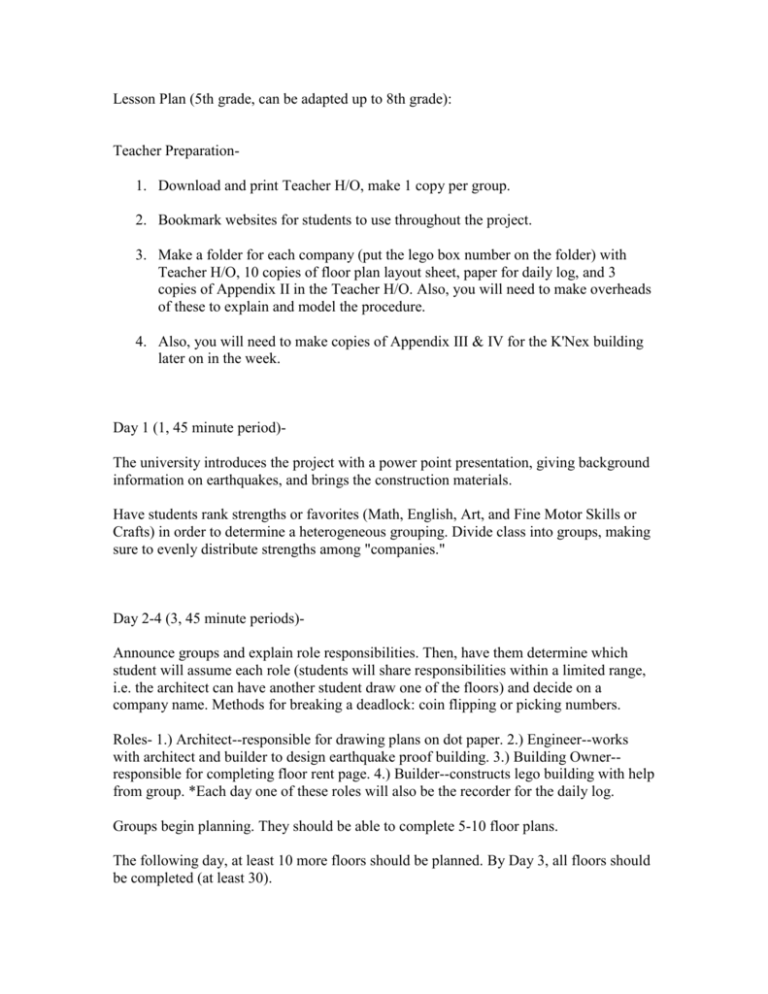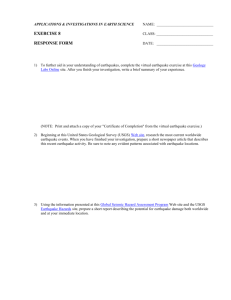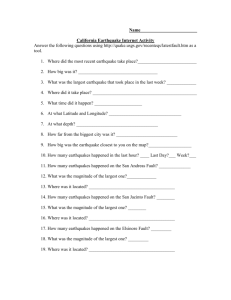here
advertisement

Lesson Plan (5th grade, can be adapted up to 8th grade): Teacher Preparation1. Download and print Teacher H/O, make 1 copy per group. 2. Bookmark websites for students to use throughout the project. 3. Make a folder for each company (put the lego box number on the folder) with Teacher H/O, 10 copies of floor plan layout sheet, paper for daily log, and 3 copies of Appendix II in the Teacher H/O. Also, you will need to make overheads of these to explain and model the procedure. 4. Also, you will need to make copies of Appendix III & IV for the K'Nex building later on in the week. Day 1 (1, 45 minute period)The university introduces the project with a power point presentation, giving background information on earthquakes, and brings the construction materials. Have students rank strengths or favorites (Math, English, Art, and Fine Motor Skills or Crafts) in order to determine a heterogeneous grouping. Divide class into groups, making sure to evenly distribute strengths among "companies." Day 2-4 (3, 45 minute periods)Announce groups and explain role responsibilities. Then, have them determine which student will assume each role (students will share responsibilities within a limited range, i.e. the architect can have another student draw one of the floors) and decide on a company name. Methods for breaking a deadlock: coin flipping or picking numbers. Roles- 1.) Architect--responsible for drawing plans on dot paper. 2.) Engineer--works with architect and builder to design earthquake proof building. 3.) Building Owner-responsible for completing floor rent page. 4.) Builder--constructs lego building with help from group. *Each day one of these roles will also be the recorder for the daily log. Groups begin planning. They should be able to complete 5-10 floor plans. The following day, at least 10 more floors should be planned. By Day 3, all floors should be completed (at least 30). Day 5-8 (4, 45 minute periods)Groups get their lego bag only after all plans are completed. Students begin building and calculate floor rent as they go. Using a mouse pad, students can try shaking their buildings to test its ability to withstand shaking. Any changes in design go on the Revised side of the floor plan layout sheet. Day 9-11 (3, 45 minute periods)Choose a representative from each group (vote or draw straws) to be a member of the K'Nex Consortium. The K'Nex Consortium does not actually have to write out a floor plan, but the rent must be calculated as they go. While the Consortium is building, Lego groups proof their log, design a company logo, and make a sign for the building. If they finish these tasks, they can research earthquake preparedness and include their findings in their daily log, i.e. what would they do if they lived in an earthquake zone and what would they put in an earthquake kit. They can also construct individual maps of earthquake magnitudes (color coded) and their location. This can be done by region, U.S., or global using http://earthquake.usgs.gov/activity/index.html. An additional activity would be using the web to research historical earthquakes. An impartial group of judges (other teachers/faculty) vote on the landmark building to be announced on Day 11. Day 12-Quake Day The university comes in with the Shaker Table, and students give a 2-3 minute presentation on their Lego building, including the total rent. Buildings are then tested 4 at a time to see which one can survive the longest. Buildings that fail must give back part of their rent. The winners from each group go into a "Shake-Off." The K'Nex group then gives a brief report on structural decisions and their building is tested. The university presents Part II of the power point presentation, which focuses on the techniques of earthquake engineering and how they apply to the Lego and K'Nex models. Day 13- Students write their results from Quake Day and can research how they could have improved their structures using Bookmarked links. A final report is written by each group. Resources: Websites: 1.) Earthquakes Near Real Time Earthquake (for daily tracking of global earthquakes) http://neic.usgs.gov/neis/bulletin USGS: Earthquake Hazards Program http://earthquake.usgs.gov Earthquake Activity, Earthquake Products, EQ Facts & Education Multidisciplinary Center for Earthquake Engineering Research http://mceer.buffalo.edu/infoService/faqs/edulinks.asp 2.) Structures and Engineering http://quake.usgs.gov/prepare/factsheets/SaferStructures http://geopubs.wr.usgs.gov/fact-sheet/fs176-95 http://www.fema.gov/library/quakef.htm http://www.fema.gov/nwz01/nwz01_21.htm E-mail: EERI -- eeriund@nd.edu, Dru Wrasse -- dwrasse@stanleyclark.org, Dr. Kurama – ykurama@nd.edu








